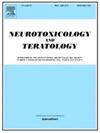Neurodevelopmental impacts of betamethasone administered in the late preterm period: An experimental study in CD-1 mice
IF 2.8
3区 医学
Q3 NEUROSCIENCES
引用次数: 0
Abstract
The safety of antenatal corticosteroid administration during the late preterm period is currently questioned. This experimental study conducted in a CD-1 mouse model aimed to determine if exposure to betamethasone in the late preterm period 1) induces behavioral changes in adulthood and 2) alters cerebral anatomy. In the prenatal group, four gravid mice were randomly assigned to receive 0.1 mg of betamethasone (around 1.82 mg/kg based on an average body weight of 55 g) or an equivalent volume of phosphate buffered saline (PBS) on gestation day 18, and yielded a total of 43 pups. This model was selected to test the impact of cumulative exposure to exogenous and endogenous steroids. In the postnatal group, six gravid mice yielded a total of 69 pups which were randomly assigned to receive betamethasone or PBS. Pups in the intervention group received 0.03 mg of betamethasone subcutaneously on postnatal day 5, at which time mouse brain development is equivalent to that of humans at 34–36 weeks' gestation. To evaluate objective 1, pups were subjected to behavioral tests on postnatal days 21–50. On postnatal day 60, structural magnetic resonance imaging (MRI) was performed to assess objective 2. Outcomes were compared between treatment groups using linear mixed models including random effects for litter and a fixed term for the interaction of treatment and sex. We used a statistical significance threshold of p < 0.05. Male mice exposed to betamethasone ante- or postnatally engaged in more social contact than those exposed to PBS (interaction of betamethasone and male sex: prenatal β = 0.09, 95 % CI (0.02, 0.17), p = 0.02; postnatal β = 0.08, 95 %CI (0.01, 0.14), p = 0.03), while female mice engaged in less social contact. MRI showed that male mice exposed to betamethasone prenatally had larger habenulas and smaller amygdala than those exposed to PBS (interaction of betamethasone and male sex: habenula β = 0.01, 95 %CI (0.004, 0.02), p = 0.01, amygdala β = −1.43, 95 %CI (−2.67, −0.21), p = 0.03), while female mice had larger amygdala and smaller habenulas. Postnatal exposure to betamethasone was associated with lower combined volume of the parietal cortex and hypothalamus (interaction of betamethasone and male sex: β = −0.32, 95 %CI (−0.58, −0.03), p = 0.04). No other significant differences in behavioral outcomes or brain volumes were identified. These results suggest that exposure to betamethasone in the late preterm period is associated with small but significant sex-specific disruptions of the limbic system, associated with social behavior disturbances.
早产后期给予倍他米松对神经发育的影响:CD-1小鼠的实验研究。
在早产后期使用皮质类固醇的安全性目前受到质疑。本实验研究在CD-1小鼠模型中进行,旨在确定在早产后期暴露于倍他米松是否会导致成年期的行为改变,以及是否会改变大脑解剖结构。在产前组,4只妊娠小鼠被随机分配接受0.1 mg倍他米松(约1.82 mg/kg,基于平均体重55 g)。或等量的磷酸盐缓冲盐水(PBS)。妊娠第18天,共产幼崽43只。选择该模型是为了测试外源性和内源性类固醇累积暴露的影响。在产后组中,6只妊娠小鼠共生产69只幼崽,随机分配接受倍他米松或PBS治疗。干预组幼鼠在出生后第5天皮下注射0.03 mg倍他米松,此时小鼠大脑发育与人类妊娠34-36 周相当。为了评估目标1,在出生后21-50天对幼犬进行行为测试。出生后第60天,结构磁共振成像(MRI)。进行评估目的2。使用线性混合模型比较处理组之间的结果,包括凋落物的随机效应和处理与性别相互作用的固定期限。我们使用p的统计显著性阈值
本文章由计算机程序翻译,如有差异,请以英文原文为准。
求助全文
约1分钟内获得全文
求助全文
来源期刊
CiteScore
5.60
自引率
10.30%
发文量
48
审稿时长
58 days
期刊介绍:
Neurotoxicology and Teratology provides a forum for publishing new information regarding the effects of chemical and physical agents on the developing, adult or aging nervous system. In this context, the fields of neurotoxicology and teratology include studies of agent-induced alterations of nervous system function, with a focus on behavioral outcomes and their underlying physiological and neurochemical mechanisms. The Journal publishes original, peer-reviewed Research Reports of experimental, clinical, and epidemiological studies that address the neurotoxicity and/or functional teratology of pesticides, solvents, heavy metals, nanomaterials, organometals, industrial compounds, mixtures, drugs of abuse, pharmaceuticals, animal and plant toxins, atmospheric reaction products, and physical agents such as radiation and noise. These reports include traditional mammalian neurotoxicology experiments, human studies, studies using non-mammalian animal models, and mechanistic studies in vivo or in vitro. Special Issues, Reviews, Commentaries, Meeting Reports, and Symposium Papers provide timely updates on areas that have reached a critical point of synthesis, on aspects of a scientific field undergoing rapid change, or on areas that present special methodological or interpretive problems. Theoretical Articles address concepts and potential mechanisms underlying actions of agents of interest in the nervous system. The Journal also publishes Brief Communications that concisely describe a new method, technique, apparatus, or experimental result.

 求助内容:
求助内容: 应助结果提醒方式:
应助结果提醒方式:


